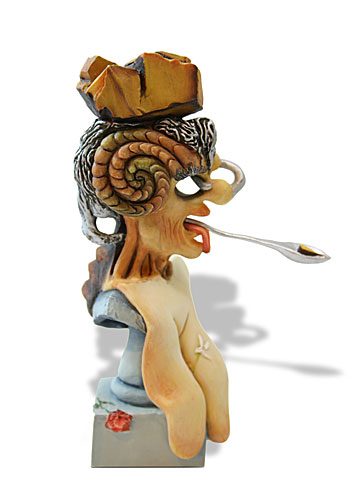This is a large Edgar Degas sculpture entitled “The Fourteen-year-old Dancer” (Petite Danseuse De Quatorze Ans, 1879-1881).
This is a highly collectible, quality, resin sculpture with hand-painted color details, matte and glossy finish. Guaranteed fully authentic and authorized piece! Absolute Mint Condition, comes new in box! Measures 13.5 in. x 6 in. x 6 in.
Comes with a full color card with an image of the original artwork and a description card about Degas and his artwork. Both cards are in four languages. This replica is faithful to the original because it includes a cloth skirt and hair bow as had the original.
Edgar Degas’ beloved sculpture of a young ballerina is the only sculpture Edgar Degas chose to exhibit throughout his lifetime. He created a revolutionary piece breaking the stereotypical cold inanimate sculptures of his time. He made his ballerina dancer come to life. Although received with some disapproval because of its stark realism, it has become one of the most time honored, beloved sculptures around the world. She represents the time honored tradition many young girls experience — the ballet class. Although sometimes association with Impressionism, his artwork has an unidealized quality which at times, more closely associates him with Realism.
This statue replica is delight. She is reproduced after over twenty lost wax bronze castings made with an added fabric tulle skirt and bodices. This replica reproduces the bronze castings and the fabric skirt. She wears a fabric bow in her hair too with a serene grace. Degas signature appears on the bottom of the base. This reproduction is a timeless addition to your art collection.
This sculpture is amazing! When the public visits a museum, they repeatedly visit the same artworks to look at them from a different perspective. This fantastic sculpture offers art lovers the ability to “view” their favorite artwork in their own home, from an entirely different perspective, and in a different dimension: 3D! Have you ever wondered what the artwork looked like from behind the painting? Or from the side? To remind you of your museum experience, each figurine comes with a color card of the original painting, information about the painter and a description of the specific figurine reproduced.
After beginning to lose his eyesight after his fiftieth birthday, Degas became increasingly dependent on his sense of touch and so started to turn from painting to sculpting. Although during the last period of his life he hardly ever showed his work to anybody, he decided after working the The Dancer for more than two years, to send his work to the impressionist exhibition in Paris.
After he had carefully sculpted the body, he had the clothes custom made: the bodice, the net dancing skirt and the ballet shoes. On top of the bodice he then worked again with wax, so this was to become a solid part of the figure when it was cast in bronze. He expected a sympathetic reactions from the audience, but they were at an utter loss. It was obviously too realistic. ‘Mister Degas dreamed of an ideal picture of ugliness. The fortunate man! He has achieved it …’, a critic wrote. He was known as a painter and now he had designed something that seemed to laugh at all the traditional values of the art of sculpting, which was something the audience just could not understand.
After this experience Degas never exhibited any of his work again. Looking back, he was clearly ahead of his time and he had developed a degree of objective realism for which his contemporaries were not in the slightest prepared. It is a lifelike sculpture, with her chin lifted into the air and her immature body, the girl is standing before us, ready to start moving whilst at the same time she seems motionless and timeless — so characteristic of the true art which outlives its time to splendidly.
THIS IS THE BEST PRICE YOU WILL FIND ANYWHERE FOR THE SAME PIECE!




Reviews
There are no reviews yet.